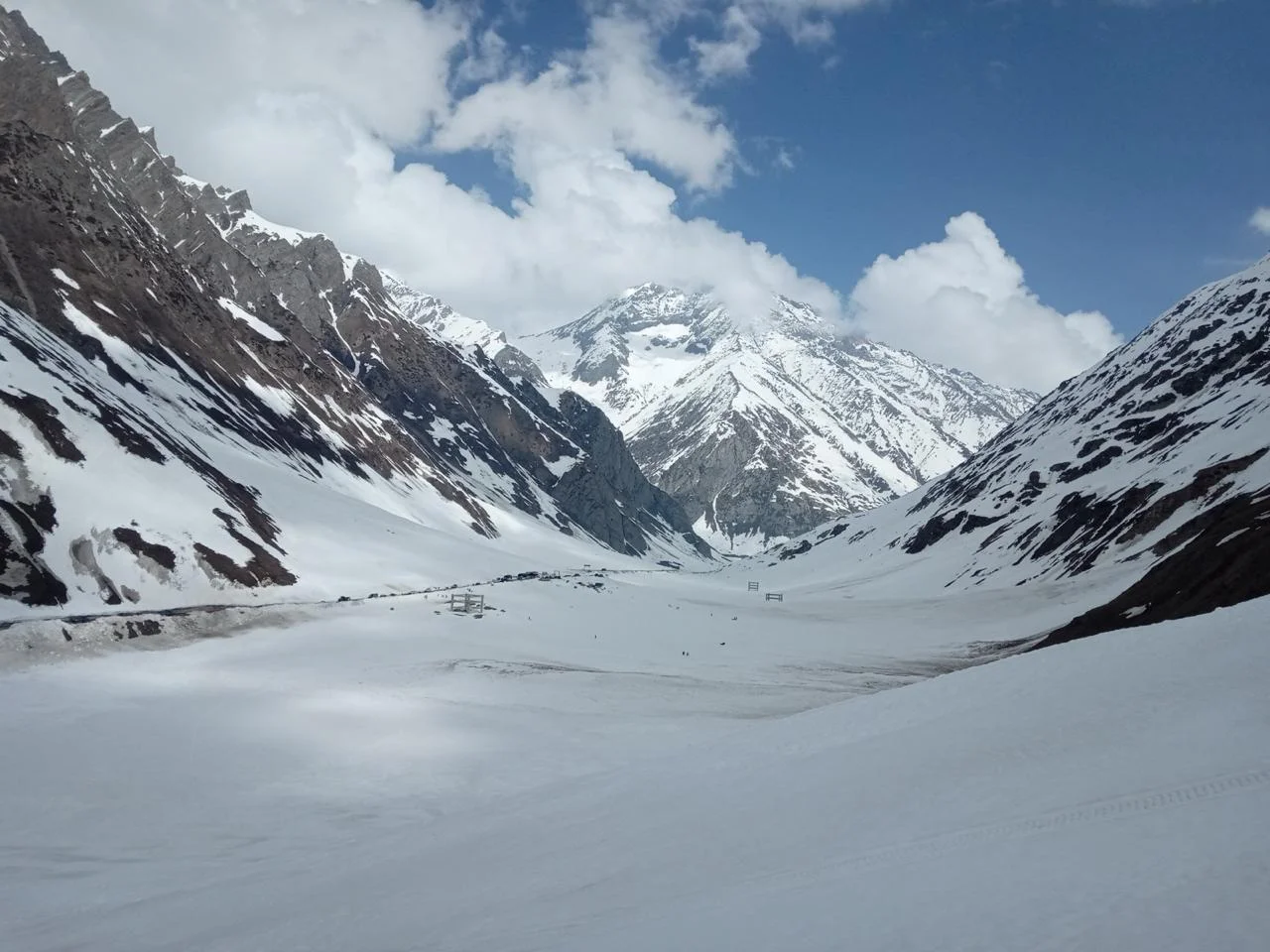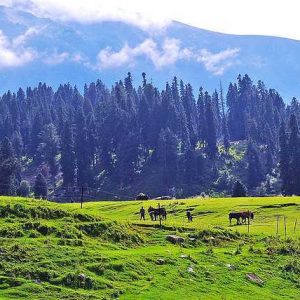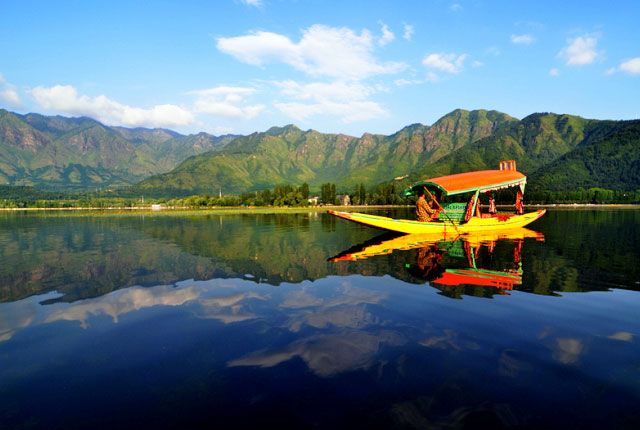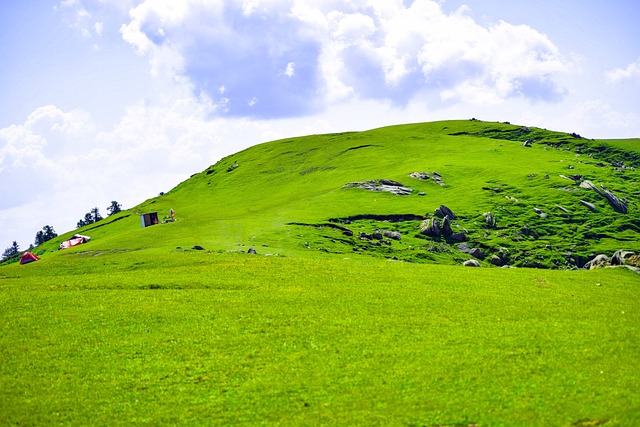
Zero Point Sonamarg
Table of Contents
ToggleOverview
Situated in the embrace of the great Himalayas, Zero Point Sonamarg is one of India’s most enchanted and unspoiled spots of high-altitude countryside in Jammu and Kashmir union territory. As one of the sights of Sonamarg tourism, this untouched meadow on a height of over 4,200 meters above sea level beckons daring travelers in quest of a glimpse of snow-capped mountains, glacial beauty, and an otherworldly tranquility that is miles away from the hustle and bustle of everyday life.





What Is Zero Point and Why It's Called So
As you set out on the legendary Zero Point hike, you find yourself in an area where Sonamarg’s green pastures abruptly end into endless stretches of ice and snow. Zero Point” is what it is called because it is the last bit of road-accessible area before the risky Zoji La Pass, which normally remains closed during winter. Here, first-time visitors get the sensation of altitude: oxygen levels drop, temperatures hover close to freezing point even in summer, and the sight of glaciers cascading down to feed water to the Sindh River makes it one of the most seen Sonamarg places in the region.
Location and Geography
Zero Point is located about 15 kilometers past Sonamarg town, on the Srinagar-Leh road. It is part of the greater Ladakh region but distinct from being a part of Kashmir’s northern frontier. Drass and Kargil are more easterly towns, but as a base camp for most tourists, Sonamarg is perfect. The road to Zero Point meanders along alpine meadows, popularly known as “Nilagrad” or blue meadows, and weaves past monstrous waterfalls falling off green moss-covered rocks. These landscapes are representative of Sonamarg camping, even though everyone would want to just undertake a day trip to Zero Point itself.
How to Reach Zero Point Sonamarg
1. By Road from Srinagar
Distance & Route
Sonamarg is situated approximately 80 kilometers from Srinagar along National Highway 1D. A scenic ride along the Sindh Valley Road would take around 2.5 to 3 hours, subject to road traffic and the weather.
Vehicle Options
Private taxis, shared taxis, and two-wheelers may be hired from Srinagar. Shared taxis to Sonamarg are available early morning from Lal Chowk. You can hire a local four-wheel-drive vehicle from Sonamarg town or opt for a guided Zero Point tour.
2. By Air
Nearest Airport
Sheikh ul-Alam Airport in Srinagar (SXR) is the gateway. Regular flights are available from major Indian cities like Delhi, Mumbai, and Bengaluru. Ground transportation from the airport to Sonamarg can be readily arranged by a hotel or travel agent.
3. By Rail
Nearest Railway Station
Jammu Tawi Railway Station is over 330 kilometers distant. Travelers prefer to disembark here and reach by road, so a longer but scenic route along the heartland of Kashmir.
Best Time to Visit Zero Point
Sonamarg weather is crucial to understand in order to arrange an unforgettable trip to Zero Point:
Winter (November to March)
There is heavy snowfall, and the road is impassable; Zoji La Pass is closed, and Zero Point is not reachable by road. This season is for experienced winter trekkers and skiers but only with prior permission and advice from experts.
Spring (April to May)
Snow melts, and wildflowers begin to emerge on the meadows, and the local shepherds expose the flocks to graze. Weather is changeable between 2°C to 10°C, and it is a picturesque time for Sonamarg tourism with reduced peak-season tourists.
Summer (June to August)
Peak tour season for Sonamarg. With average temperatures of 15°C and the occasional afternoon shower of rain, the road to Zero Point is still in full swing. This season offers the best view of glaciers and is best for family picnics, campings, and nature walks under the aegis of an expert.
Fall (September to October)
Crisp air with open skies displaying golden leaves. Snows for the first time will be visible by late October, but early autumn is an ideal time to attempt camping in Sonamarg and day trekking to Zero Point.
Climate and Weather Conditions
Zero Point’s high-altitude climate demands caution and preparations:
Temperature Fluctuations
Even during summer, nights will drop below 0°C. Do not forget to wear layered garments and windproof jackets.
UV Radiation
Thinning of air raises UV exposure. UV400 sunglasses, broad-spectrum sunscreen, and wide hats are essential.
Altitude Sickness
Acute Mountain Sickness (AMS) may hit anybody at an elevation over 2,500 m. One overnight stay at Sonamarg town (2,730 m) prior to trying further up to 4,200 m will acclimatize. Stay hydrated and adopt prophylactic measures like acetazolamide after consulting a medical professional.
Top Attractions Near Zero Point
While Zero Point itself is a treasure, the greater Sonamarg region has mixed experiences to share:
Thajiwas Glacier
A pony ride from the town of Sonamarg, these sparkling ice plateaus are perfect for snowball battles and beginner-level Zero Point trekking training.
Borasu Pass
For adventure enthusiasts, the Borasu Pass trek is a challenging route from Sonamarg to Uttarakhand, crossing remote valleys and high-altitude lakes.
Nilagrad Meadows
Also referred to as the “Blue Meadows” due to the wildflowers blanketing the grasslands, these meadows are a must-visit in late spring and early summer.
Sindh River
White-water rafting upstream on the Sindh River offers adrenaline-charged activity among stunning canyon walls.
Gangabal Lake
Untouched alpine lake accessed by a moderate trek, surrounded by granite peaks and snow-covered ridges.
Activities at Zero Point Sonamarg
Zero Point is not just for the tourists. Adventure-seekers can experience:
Glacier Walks
Trek across terminal moraine and ice fields, guided by porters who know every ridge and crevasse.
Photography Tours
Professional and enthusiast photographers alike travel here for golden-hour shots of sun-tanned peaks and reflected ice patches.
Birdwatching
Himalayan monal, snow partridges, and other cold-climate birds hold court in the upper reaches; a pair of binoculars can transform a simple trek into an ornithological adventure.
Camping Under the Stars
Though regulated, camping at Zero Point is possible on permit. Imagine sleeping under starlight, far from light pollution.
Skiing and Snowboarding
Late winter and early spring see ski resorts opening up to adventure-seekers—real off-piste slopes with fresh powder and stunning views.
Accommodation Options
Where Zero Point has no fixed accommodations, Sonamarg town provides the option for a variety of budgets:
Luxury Resorts
Luxury resorts with hot rooms, decent food, and spa. Ideal for families and those seeking comfort.
Mid-Range Hotels
Spick-and-span rooms with bathroom, normally owned and operated by local families. A few offer day outings to Zero Point.
Guesthouses and Homestays
Experience the hospitality of the Kashmiris. Food is normally home-cooked, with dishes like saffron rice and rogan josh.
Campsites
For the serious traveler, riverside and meadow camps with plain tents and shared facilities provide a roughing-it experience. Book these well in advance during tourist season.
Local Food and Eating
While visiting Sonamarg attractions, do not miss the local food:
Kashmiri Wazwan
A multi-course meat dish such as goshtaba (meatballs prepared in yogurt) and kebabs served on brass plates.
Sheermal and Girda
Local breads, mildly sweetened, to accompany curries.
Street Snacks
Thinly sliced apples from nearby orchards or hot sweet kahwa (saffron tea) in road-side stalls, perfect after a cold hike to Zero Point.
Safety Tips and Travel Advice
For your best time on your Zero Point trek and Sonamarg sightseeing, keep these in mind:
Permits & Regulations
While local travelers do not typically need special permits, foreign travelers must have Protected Area Permits (PAP) to proceed beyond Sonamarg.
Travel Insurance
Ensure that your policy covers high-altitude trekking, emergency evacuation, and medical repatriation.
Local Guides
Carrying a licensed guide ensures added safety, supports the local economy, and enhances your understanding of the region’s ecology and culture.
Respect Local Customs
Dress conservatively when dealing with villagers. Kashmiri hospitality is built on respect and good manners.
Emergency Contacts
Keep local emergency numbers, your embassy (for international visitors), and your insurance helpline within reach.
Responsible Tourism and Eco-Friendly Practices
Protecting the fragile Himalayan ecosystem is crucial:
Pack In, Pack Out
Carry reusable water bottles and avoid single-use plastics. Dispose of all waste responsibly.
Stay on Marked Trails
Off-trail exploration can damage alpine flora and disturb wildlife habitats.
Support Local Vendors
Buy handicrafts, woolens, and bakery items from villagers to make sure tourism income directly reaches communities.
Energy Conservation
Switch off lights, heaters, and electric geysers when not required. Most guesthouses operate using limited sources of power.
Packing List and Preparation
When preparing for camping in Sonamarg and your Zero Point trek, order of priority is:
Clothing
Thermal base wear, fleece jacket, waterproof outerwear, woolen caps, gloves, and tough trekking shoes.
Gear
Daypack (20–30 L), trekking poles, headlamp with extra batteries, sunglasses with UV protection, and sunscreen.
Health & Safety
First-aid kit, altitude sickness pills (if prescribed), water purification tablets, and high-energy foods such as nuts and protein bars.
Navigation & Communication
Offline maps, power banks, satellite phone or local SIM card with coverage in Sonamarg, and emergency whistle.
Photographic Opportunities
Photographers flock to Zero Point for its stunning landscapes:
- Golden Hour on the Glacial Moraine
Dawn and dusk give golden tones to ice and rock, ideal for wide-angle photographs.
- Sindh River Panorama
Framing the turquoise river against snow-roofed ridges encapsulates the essence of the area.
- Local Flora and Fauna
Macro lenses come alive with Himalayan edelweiss and butterflies in the mountains.
- Night Sky Photography
Low light pollution provides a celestial canvas—perfect for star trails and Milky Way shots.
Frequently Asked Questions
Q: Is Zero Point Sonamarg open throughout the year?
No. The highway after Sonamarg remains shut in winter (November–March) due to excessive snowfall and avalanche danger.
Q: Are novices allowed to attempt the Zero Point trek?
Yes. The drive from Sonamarg town to Zero Point is an easy ride for the most part, with short flat walks later. Acclimatization is still required.
Q: Does Zero Point have mobile network facilities?
There’s patchy coverage. Some private operators and BSNL have limited connectivity; carry a power bank.
Q: What wildlife should I expect to see?
Himalayan marmots, mountain goats, and other birds like the Himalayan monal. Rarities but well worth the sighting.
Q: Do I need photography or drone permission?
Commercial drone flight and photography require permission from local authorities. Always refer to the rules before taking the snap.
Conclusion
For the traveler seeking the ultimate Himalayan adventure, Zero Point Sonamarg is a perfect blend of adventure, nature, and culture. From the excitement of glacier treks and snowfall skiing in Sonamarg to the peaceful wonder of alpine meadows and star-studded nights, every experience at Zero Point is like a discovery. By prudently planning—selecting the most suitable time to visit Sonamarg, dressing accordingly, being sensitive to local traditions, and encouraging eco-friendly initiatives—you will make memories that last an eternity. So lace up your hiking boots, breathe the crisp mountain air, and head for Zero Point—the true frontier of Kashmir’s breathtaking wilderness.
How to book Kashmir tour?
Contact a travel agency that specializes in Kashmir tours. You can reach out to the following for assistance:
- Phone:
- +91 7889 655596
- +91 7006 891267
- Email:
Inquire about tour packages, itineraries, and pricing, and confirm your booking for a memorable winter experience!
People Also Ask
What is Zero Point Sonamarg?
Zero Point Sonamarg is a high-altitude meadow located approximately 15 km beyond Sonamarg town in Jammu & Kashmir. At over 4,200 meters above sea level, it offers pristine glacial vistas and snow-clad landscapes.
Why is it called Zero Point?
It’s the farthest motorable point before the Zoji La Pass on the Srinagar-Leh highway—marking the “zero” limit of road access into the high Himalayas.
How do I reach Zero Point from Srinagar?
Take NH1D from Srinagar to Sonamarg (about 80 km), then hire a local 4×4 taxi or join a guided tour for the final 15 km to Zero Point.
When is the best time to visit Zero Point Sonamarg?
June to September—summer months ensure the road is open, flowers bloom in Nilagrad meadows, and the weather is mild for trekking and camping.
Is Zero Point accessible year-round?
No. Heavy winter snowfall from November to March closes Zoji La Pass, making Zero Point inaccessible by road during that time.
Do I need permits to visit Zero Point Sonamarg?
Domestic tourists do not need permits, but foreign nationals must obtain a Protected Area Permit (PAP) to travel beyond Sonamarg.
What altitude sickness precautions should I take?
Acclimatize by staying a night in Sonamarg (2,730 m), stay hydrated, ascend slowly, and consider consulting a doctor about using acetazolamide.
Are there guided treks to Zero Point?
Yes—local operators offer day treks and multi-day packages that include guides, porters, and camping equipment.
Can beginners attempt the Zero Point trek?
Absolutely. The walk from the drop-off point is short and relatively flat, making it beginner-friendly for those with moderate fitness.
What kind of vehicle is required for the Sonamarg to Zero Point drive?
A high-clearance, four-wheel-drive vehicle is recommended due to the rough terrain and unpaved mountain roads.
Is mobile network available at Zero Point?
Coverage is limited. BSNL and a few private operators may work sporadically. Carry a power bank and download offline maps.
What should I pack for a Zero Point Sonamarg trip?
Layered clothing, a waterproof jacket, trekking boots, UV-protection sunglasses, sunscreen, a first-aid kit, and energy snacks are essential.
Can I camp at Zero Point Sonamarg?
Yes—camping is permitted with prior permission and the support of a local guide. Basic tent facilities can be arranged.
What wildlife might I see around Zero Point?
Himalayan marmots, snow partridges, and the elusive Himalayan monal are sometimes spotted in the alpine meadows.
Are there accommodations near Zero Point?
No lodges exist at Zero Point. Overnight stays are available in Sonamarg town, with options ranging from luxury resorts to budget guesthouses.
Is it safe to drive to Zero Point in monsoon season?
The route is usually stable from June to September, but sudden rain can cause landslides. Always check local conditions before traveling.
Can I visit Zero Point on a motorcycle?
Yes—many riders travel by motorcycle up to Sonamarg, then hire a 4×4 for the final, more rugged stretch to Zero Point.
What photography opportunities does Zero Point offer?
Capture dramatic glacier formations, snow-covered valleys, alpine wildflowers, and clear night skies—ideal for both landscape and astrophotography.
Is there food available en route to Zero Point?
Small dhabas in Sonamarg and a few roadside stalls sell snacks, tea (kahwa), and basic meals. It’s advisable to carry your own water and light snacks.
Can I combine Zero Point with a Thajiwas Glacier visit?
Yes—many day trips from Srinagar include both Thajiwas Glacier (via pony ride) and a scenic drive to Zero Point in one itinerary.
What are the altitude and temperature ranges at Zero Point?
Zero Point sits at about 4,200 meters. Summer temperatures range from 0°C to 15°C, and nighttime temperatures often fall below freezing.
Is skiing available near Zero Point?
Yes—off-piste skiing is possible in late winter and early spring around Sonamarg, including near Zero Point, though it’s for experienced skiers only.
Do I need travel insurance for Zero Point Sonamarg?
Travel insurance is strongly recommended. Ensure it includes high-altitude trekking, medical coverage, and emergency evacuation.
Are drones allowed at Zero Point?
Drone usage requires prior permission from local authorities. Unauthorized use may result in fines or confiscation.
How can I support eco-friendly tourism at Zero Point?
Stay on marked trails, use refillable water bottles, carry your trash out, and hire local guides to support the regional economy and protect the ecosystem.




